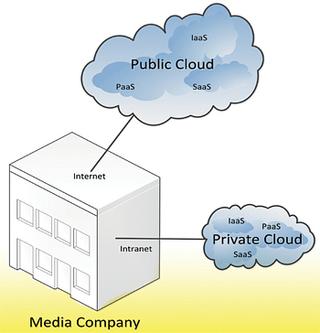Computing on Cloud Nine

Author Henry David Thoreau said, "You must not blame me if I do talk to the clouds." While it may seem odd to talk to a cloud, this is actually what is happening more and more in our industry.
In October, I chaired a session at the SMPTE conference on Service Oriented Architecture (SOA) and "The Cloud" in media. It was definitely a hot topic of growing interest to media businesses.
In simplest terms the cloud is about accessing resources over a network. That network can be the Internet or an intranet and the resources can be computing resources or applications.
WHY USE THE CLOUD?
The cloud is a closely related concept to SOA. In SOA, work steps are broken down into individual reusable services. How and where those services are accessed is not important in SOA. This is where the cloud can come in. Those services can be accessed over the Internet for example.
Why use the cloud? The biggest reason is to increase the elasticity of your resources. Cloud resources are typically accessed on a "pay as you go" model. Like a utility, you only really pay for what you actually use. If one month you need more, you pay a higher fee. If the next month you need less, you pay less. The cloud saves money.
It is also the most efficient use of resources. Typically clouds are set up with virtualization technologies that maximize the usage of each machine in the data center. This saves electricity and maximizes the use of space.
Clouds can be either "Public" or "Private." (See Fig. 1.) Many of the cloud services you are aware of today are public. This means they are accessed over the public Internet and they suffer the same limitations as other Internet services (speed/security). It also means they are accessible from anywhere.
The other type of cloud is private. In other words, it is a cloud within your enterprise. In some cases it may even use the same technology as the public cloud or emulate the same interfaces as the public cloud. But the clear advantage here is speed of access and securing of the infrastructure within the enterprise.
TYPES OF SERVICES
There are three major types of services that can be provided in the cloud. The first is called Infrastructure as a Service (IaaS). With this, you are accessing simple compute and storage resources in the cloud. What you do with those compute or storage resources is managed by you.
A commonly used example of these types of services is Amazon's S3 (storage) and EC2 (compute) services. It is easy to see how the media industry can take advantage of cloud-based storage for our media and computing for intensive tasks like rendering or transcoding.

Fig. 1: Public or Private Clouds The next type of cloud service is Platform as a Service (PaaS). In this, a complete "machine" with computing, storage, an operating system and security is typically provided. The operating system and other platform capabilities are updated and managed for you in the cloud. An example of this would be Microsoft Azure.
Software as a Service (SaaS) is the top of the cloud stack. These are full application services provided in the cloud. You don't worry in any way about the details of how the application runs or is maintained. You access it and use it.
There are already a couple of media-specific applications in this class (editing, graphics, MAM) and I expect to see an explosion of them in the next two years. I can also predict that the big buzz words at this year's NAB Show will be "The Cloud."
Obviously, the cloud is not perfect. There are real problems—especially for media—in using the cloud. First and foremost is speed of access. We have a need often for real-time access to media and anything that slows that can be unacceptable. The good news is, with increasing use of file-based technologies, a growing percentage of media workflows are non-real time and don't have an issue.
Another major concern is security. This can come from concerns about securing access by others to your assets and resources or the feeling of insecurity from putting major parts of your infrastructure in the hands of other companies. Even with these issues, the advantages of the cloud certainly outweigh the disadvantages in many applications.
The filmmaker Leonard Levinson said, "A pessimist sees only the dark side of the clouds, and mopes; a philosopher sees both sides, and shrugs; an optimist doesn't see the clouds at all—he's walking on them."
It is time to find the ways you can use clouds in your work. It will definitely make you more flexible and responsive. You can Count on IT!
John Footen is the chief technology officer at Chime Media. He is also co-author of the book "Service-Oriented Media Enterprise." He can be reached at jfooten@chimemedia.com.
Get the TV Tech Newsletter
The professional video industry's #1 source for news, trends and product and tech information. Sign up below.
